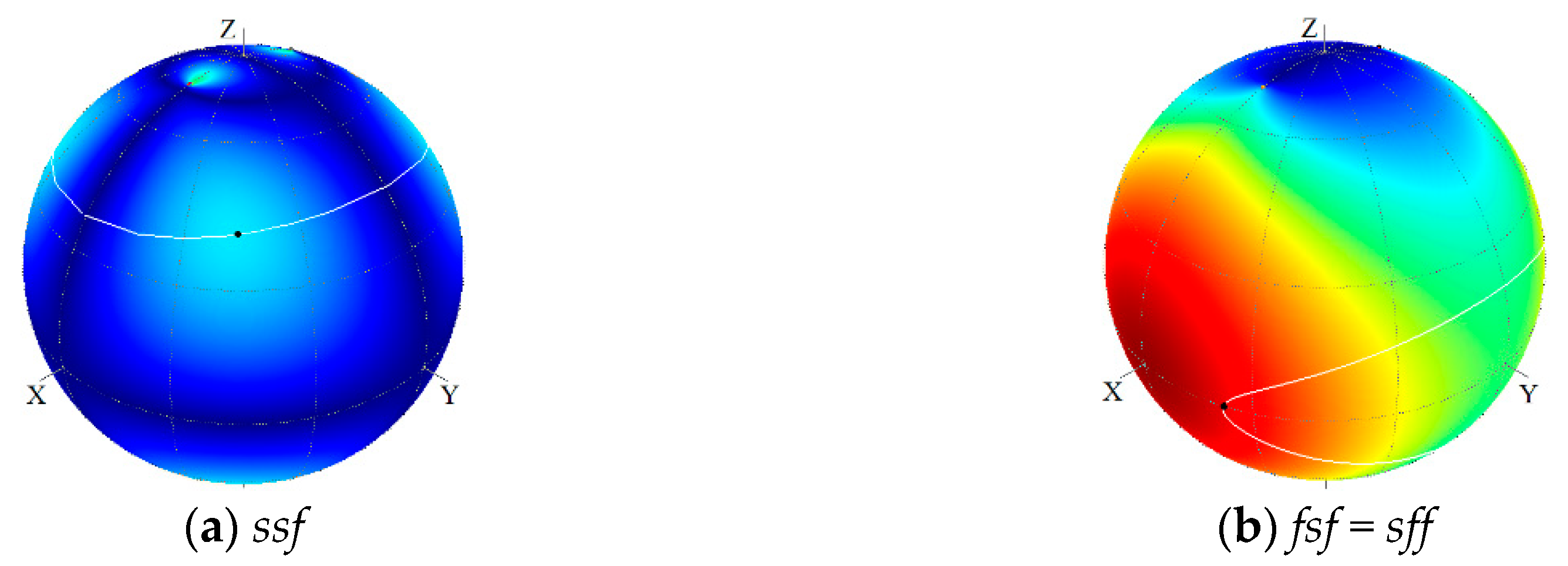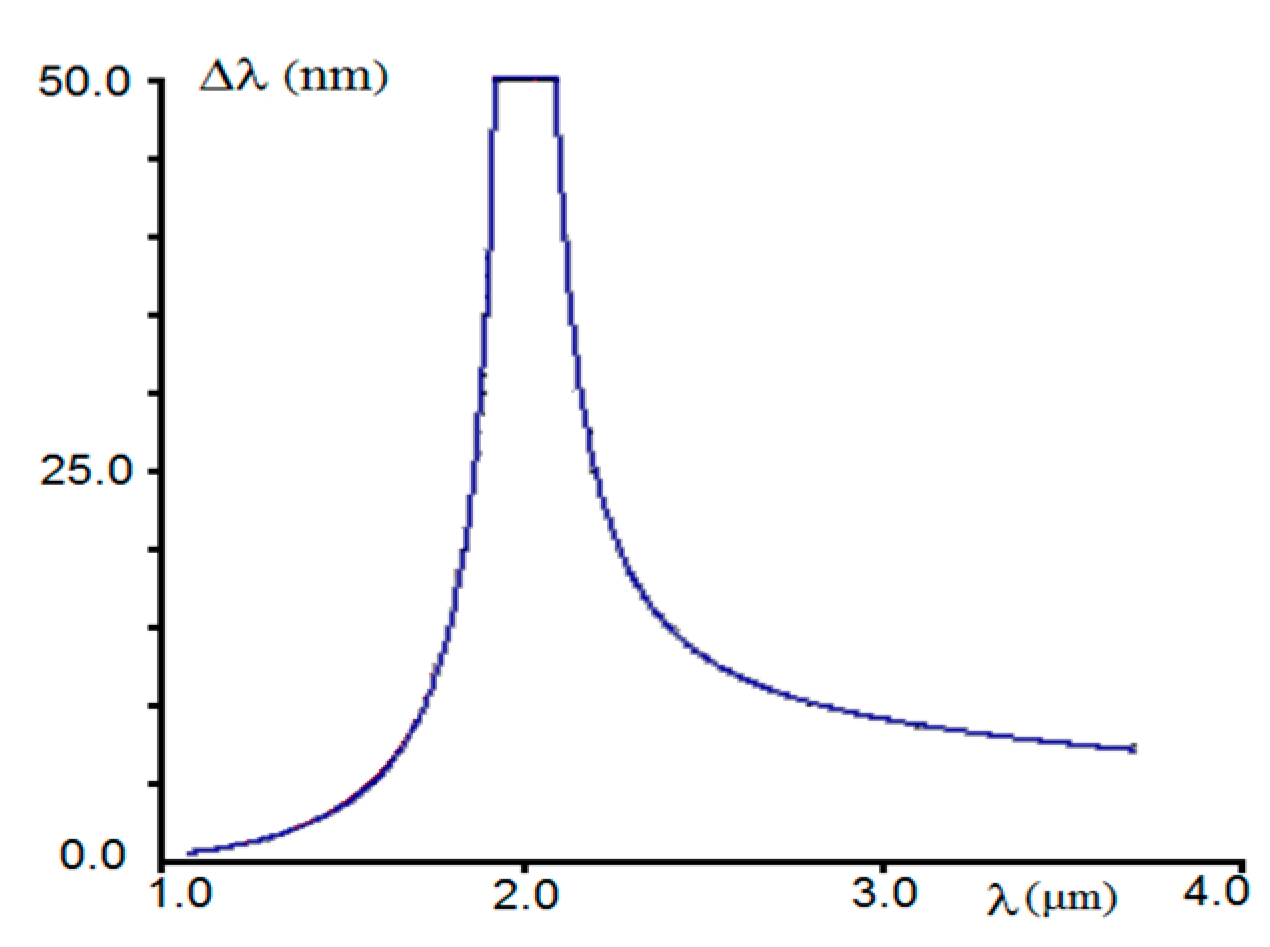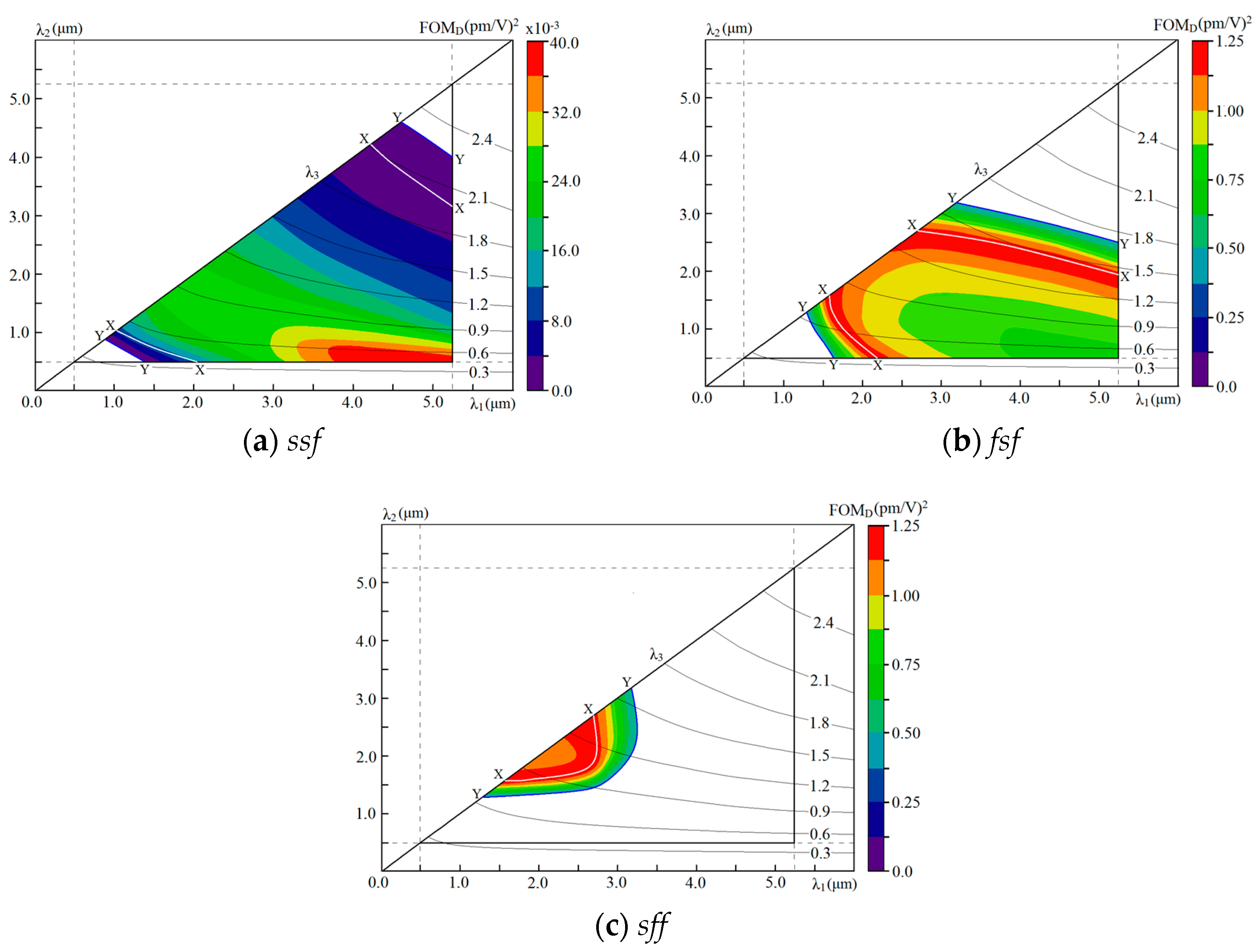Frequency Conversion in KTP Crystal and Its Isomorphs
Abstract
:1. Introduction
2. General Features of Frequency Conversion
3. Temperature-Noncritical Processes of Frequency Conversion
4. Conclusions
Author Contributions
Funding
Conflicts of Interest
References
- Zumsteg, F.C.; Bierlein, J.D.; Gier, T.E. KxRb1−xTiOPO4: A new nonlinear optical material. J. Appl. Phys. 1976, 47, 4980–4985. [Google Scholar] [CrossRef]
- Dezhong, S.; Chaoen, H. A new nonlinear optical crystal KTP. Prog. Cryst. Growth Charact. 1985, 11, 269–274. [Google Scholar] [CrossRef]
- Jacco, J.C. KTiOPO4 (KTP)—Past, present, and future. Proc. SPIE 1988, 968, 93–99. [Google Scholar]
- Bierlein, J.D. Potassium titanyl phosphate (KTP): Properties, recent advances and new applications. Proc. SPIE 1989, 1104, 2–12. [Google Scholar]
- Bierlein, J.D.; Vanherzeele, H. Potassium titanyl phosphate: Properties and new applications. J. Opt. Soc. Am. B 1989, 6, 622–633. [Google Scholar] [CrossRef]
- Stucky, G.D.; Phillips, M.L.F.; Gier, T.E. The potassium titanyl phosphate structure field: A model for new nonlinear optical materials. Chem. Mater. 1989, 1, 492–509. [Google Scholar] [CrossRef]
- Cheng, L.K.; Bierlein, J.D. Crystal growth of KTiOPO4 isomorphs from tungstate and molybdate fluxes. J. Cryst. Growth 1991, 110, 697–703. [Google Scholar] [CrossRef]
- Thomas, P.A.; Mayo, S.C.; Watts, B.E. Crystal structures of RbTiOAsO4, KTiO(P0.58,As0.42)O4, RbTiOPO4 and (Rb0.465,K0.535)TiOPO4, and analysis of pseudo symmetry in crystals of the KTiOPO4 family. Acta Cryst. B 1992, 48, 401–407. [Google Scholar] [CrossRef]
- Cheng, L.K.; Bierlein, J.D. KTP and isomorphs—Recent progress in device and material development. Ferroelectrics 1993, 142, 209–228. [Google Scholar] [CrossRef]
- Cheng, L.K.; Cheng, L.T.; Bierlein, J.D.; Zumsteg, F.C.; Ballman, A.A. Properties of doped and undoped crystals of single domain KTiOAsO4. Appl. Phys. Lett. 1993, 62, 346–348. [Google Scholar] [CrossRef]
- Cheng, L.K.; Cheng, L.T.; Galperin, J.; Hotsenpiller, P.A.M.; Bierlein, J.D. Crystal growth and characterization of KTiOPO4 isomorphs from the self-fluxes. J. Cryst. Growth 1994, 137, 107–115. [Google Scholar] [CrossRef]
- Wang, J.; Wei, J.; Liu, Y.; Shi, L.; Jiang, M.; Hu, X.; Jiang, S. Growth and properties of some KTP family crystals. Proc. SPIE 1996, 2897, 10–16. [Google Scholar]
- Wang, J.; Wei, J.; Liu, Y.; Yin, X.; Hid, X.; Shao, Z.; Jiang, M. A survey of research on KTP and its analogue crystals. Prog. Cryst. Growth Charact. Mater. 2000, 40, 3–15. [Google Scholar] [CrossRef]
- Zhang, K.; Wang, X. Structure sensitive properties of KTP-type crystals. Chin. Sci. Bull. 2001, 46, 2028–2036. [Google Scholar]
- Roth, M.; Tseitlin, M.; Angert, N. Composition-dependent electro-optic and nonlinear optical properties of KTP-family crystals. Opt. Mater. 2006, 28, 71–76. [Google Scholar] [CrossRef]
- Sorokina, N.I.; Voronkova, V.I. Structure and properties of crystals in the potassium titanyl phosphate family: A review. Crystallogr. Rep. 2007, 52, 80–93. [Google Scholar] [CrossRef]
- Satyanarayan, M.N.; Deepthy, A.; Bhat, H.L. Potassium titanyl phosphate and its isomorphs: Growth, properties, and applications. Crit. Rev. Solid State Mater. Sci. 2010, 24, 103–191. [Google Scholar] [CrossRef]
- Phillips, M.L.F.; Harrison, W.T.A.; Gier, T.E.; Stucky, G.D. SHG tuning in the KTP structure field. Proc. SPIE 1989, 1104, 225–231. [Google Scholar]
- Thomas, P.A.; Glazer, A.M.; Watts, B.E. Crystal structure and nonlinear optical properties of KSnOPO4 and their comparison with KTiOPO4. Acta Crystallogr. B 1999, 46, 333–343. [Google Scholar] [CrossRef]
- Solé, R.; Nikolov, V.; Koseva, I.; Peshev, P.; Ruiz, X.; Zaldo, C.; Martín, M.J.; Aguilo, M.; Díaz, F. Conditions and possibilities for rare-earth doping of KTiOPO4 flux-grown single crystals. Chem. Mater. 1997, 9, 2745–2749. [Google Scholar] [CrossRef]
- Gavaldà, J.; Carvajal, J.J.; Mateos, X.; Aguiló, M.; Díaz, F. Dielectric properties of Yb3+ and Nb5+ doped RbTiOPO4 single crystals. J. Appl. Phys. 2012, 111, 034106. [Google Scholar] [CrossRef]
- Urenski, P.; Rosenman, G.; Molotskii, M. Polarization reversal and domain anisotropy in flux-grown KTiOPO4 and isomorphic crystals. J. Mater. Res. 2001, 16, 1493–1499. [Google Scholar] [CrossRef]
- Shur, V.Y.; Pelegova, E.V.; Akhmatkhanov, A.R.; Baturin, I.S. Periodically poled crystals of KTP family: A review. Ferroelectrics 2016, 496, 49–69. [Google Scholar] [CrossRef]
- Laudenbach, F.; Jin, R.-B.; Greganti, C.; Hentschel, M.; Walther, P.; Hübel, H. Numerical Investigation of Photon-Pair Generation in Periodically Poled MTiOXO4 (M = K, Rb, Cs; X = P, As). Phys. Rev. Appl. 2017, 8, 024035. [Google Scholar] [CrossRef]
- Houe, M.; Townsend, P.D. An introduction to methods of periodic poling for second-harmonic generation. J. Phys. D Appl. Phys. 1995, 28, 1747–1763. [Google Scholar] [CrossRef]
- Laubacher, D.B.; Guerra, V.L.; Chouinard, M.P.; Liou, J.-Y.; Wyat, P.H. Fabrication and performance of KTP optoelectronic modulators. Proc. SPIE 1988, 993, 80–86. [Google Scholar]
- Bierlein, J.D.; Arweiler, C.B. Electro-optic and dielectric properties of KTiOPO4. Appl. Phys. Lett. 1986, 49, 917–919. [Google Scholar] [CrossRef]
- Bierlein, J.D.; Ferretti, A.; Brixner, L.H.; Hsu, W.Y. Fabrication and characterization of optical waveguides in KTiOPO4. Appl. Phys. Lett. 1987, 50, 1216–1218. [Google Scholar] [CrossRef]
- Noda, K.-I.; Sakamoto, W.; Yogo, T.; Hirano, S.-I. Alkoxy-Derived KTiOPO4 (KTP) Fibers. J. Am. Ceram. Soc. 1997, 80, 2437–2440. [Google Scholar] [CrossRef]
- Butt, M.A.; Pujol, M.C.; Solé, R.; Ródenas, A.; Lifante, G.; Aguiló, M.; Díaz, F.; Khonina, S.N.; Skidanov, R.V.; Verma, P. Fabrication of optical waveguides in RbTiOPO4 single crystals by using different techniques. Proc. SPIE 2016, 9807, 98070C. [Google Scholar]
- Karpiński, M.; Radzewicz, C.; Banaszek, K. Experimental characterization of three-wave mixing in a multimode nonlinear KTiOPO4 waveguide. Appl. Phys. Lett. 2009, 94, 181105. [Google Scholar] [CrossRef]
- Webjorn, J.; Siala, S.; Nam, D.W.; Waarts, R.G.; Lang, R.J. Visible laser sources based on frequency doubling in nonlinear waveguides. IEEE J. Quant. Electron. 1997, 33, 1673–1686. [Google Scholar] [CrossRef]
- Butt, M.A.; Nguyen, H.D.; Ródenas, A.; Romero, C.; Moreno, P.; Aldana, J.R.V.; Aguiló, M.; Solé, R.M.; Pujol, M.C.; Díaz, F. Low-repetition rate femtosecond laser writing of optical waveguides in KTP crystals: analysis of anisotropic refractive index changes. Opt. Express. 2015, 23, 15343–15355. [Google Scholar] [CrossRef] [PubMed]
- Bierlein, J.D.; Ferretti, A.; Roelofs, M. KTiOPO4 (KTP): A new material for optical waveguide applications. Proc. SPIE 1989, 994, 160–168. [Google Scholar]
- Cugat, J.; Solé, R.; Carvajal, J.J.; Mateos, X.; Massons, J.; Lifante, G.; Díaz, F.; Aguiló1, M. Channel waveguides on RbTiOPO4 by Cs+ ion exchange. Opt. Lett. 2013, 38, 323–325. [Google Scholar] [CrossRef] [PubMed]
- Butt, M.A.; Pujol, M.C.; Solé, R.; Ródenas, A.; Lifante, G.; Wilkinson, J.S.; Aguiló, M.; Díaz, F. Channel waveguides and Mach-Zehnder structures on RbTiOPO4 by Cs+ ion exchange. Opt. Mater. Express. 2015, 5, 1183–1194. [Google Scholar] [CrossRef]
- Butt, M.A.; Solé, R.; Pujol, M.C.; Ródenas, A.; Lifante, G.; Choudary, A.; Murugran, G.S.; Shepherd, D.P.; Wilkinson, J.S.; Aguiló, M.; et al. Fabrication of Y-splitters and Mach-Zehnder Structures on (Yb, Nb): RbTiOPO4/ RbTiOPO4 Epitaxial Layers by Reactive Ion Etching. J. Lightwave Technol. 2015, 33, 1863–1871. [Google Scholar] [CrossRef]
- Hagerman, M.E.; Poeppelmeier, K.R. Review of the Structure and Processing-Defect-Property Relationships of Potassium Titanyl Phosphate: A Strategy for Novel Thin-Film Photonic Devices. Chem. Mater. 1995, 7, 602–621. [Google Scholar] [CrossRef]
- Berger, V. Nonlinear Photonic Crystals. Phys. Rev. Lett. 1998, 81, 4136–4139. [Google Scholar] [CrossRef]
- Golcondaa, R.K.; Carvajal, J.J.; Pujol, M.C.; Mateos, X.; Aguiló, M.; Diaz, F.; Vázquez de Aldana, J.R.; Romero, C.; Méndez, C.; Moreno, P.; et al. Fabrication of photonic structures in crystals of the KTiOPO4 family by ultrafast laser ablation. Phys. Procedia 2010, 8, 126–135. [Google Scholar] [CrossRef]
- Mounaix, P.; Sarger, L.; Caumes, J.P.; Freysz, E. Characterization of non-linear potassium crystals in the terahertz frequency domain. Opt. Commun. 2004, 242, 631–639. [Google Scholar] [CrossRef]
- Kitaeva, G.K. Terahertz generation by means of optical lasers. Laser Phys. Lett. 2008, 5, 559–576. [Google Scholar] [CrossRef]
- Antsygin, V.D.; Kaplun, A.B.; Mamrashev, A.A.; Nikolaev, N.A.; Potaturkin, O.I. Terahertz optical properties of potassium titanyl phosphate crystals. Opt. Express 2014, 22, 25436–25443. [Google Scholar] [CrossRef] [PubMed]
- Wu, M.-H.; Chiu, Y.-C.; Wang, T.-D.; Zhao, G.; Zukauskas, A.; Laurell, F.; Huang, Y.-C. Terahertz parametric generation and amplification from potassium titanyl phosphate in comparison with lithium niobate and lithium tantalate. Opt. Express 2016, 24, 25964–25973. [Google Scholar] [CrossRef] [PubMed]
- Li, Z.; Wang, S.; Wang, M.; Wang, W. Terahertz generation based on cascaded difference frequency generation with periodically-poled KTiOPO4. Curr. Opt. Photonics 2017, 1, 138–142. [Google Scholar] [CrossRef]
- Nikogosyan, D.N. Nonlinear Optical Crystals: A Complete Survey; Springer Science & Business Media: New York, NY, USA, 2005; p. 405. [Google Scholar]
- Andreev, Y.M.; Arapov, Y.D.; Grechin, S.G.; Kasyanov, I.V.; Nikolaev, P.P. Functional possibilities of nonlinear crystals for frequency conversion: uniaxial crystals. Quantum Electron. 2016, 46, 33–38. [Google Scholar] [CrossRef]
- Andreev, Y.M.; Arapov, Y.D.; Grechin, S.G.; Kasyanov, I.V.; Nikolaev, P.P. Functional possibilities of nonlinear crystals for laser frequency conversion: Biaxial crystals. Quantum Electron. 2016, 46, 995–1001. [Google Scholar] [CrossRef]
- Kato, K.; Takaoka, E. Sellmeier and thermo-optic dispersion formulas for KTP. Appl. Opt. 2002, 41, 5040–5044. [Google Scholar] [CrossRef] [PubMed]
- Kato, K. Temperature insensitive SHG at 0,531 μm in KTP. IEEE J. Quant. Electron. 1992, 28, 1974–1976. [Google Scholar] [CrossRef]
- Mikami, T.; Okamoto, T.; Kato, K. Sellmeier and thermo-optic dispersion formulas for RbTiOPO4. Opt. Mater. 2009, 31, 1628–1630. [Google Scholar] [CrossRef]
- Kato, K.; Takaoka, E.; Umemura, N. Thermo-optic dispersion formula for RbTiOAsO4. Jpn. J. Appl. Phys. 2003, 42, 6420–6423. [Google Scholar] [CrossRef]
- Kato, K.; Umemura, N. Sellmeier and thermo-optic dispersion formulas for KTiOAsО4. In Proceedings of the Conference on Lasers and Electro-Optics, San Jose, CA, USA, 4–9 May 2008; Optical Society of America: Washington, DC, USA, 2008. [Google Scholar]
- Mikami1, T.; Okamoto, T.; Kato, K. Sellmeier and thermo-optic dispersion formulas for CsTiOAsO4. J. Appl. Phys. 2011, 109, 023108. [Google Scholar] [CrossRef]
- Jacco, J.C.; Loiacono, G.M.; Jaso, M.; Mizell, G.; Greenberg, B. Flux growth and properties of KTiOPO4. J. Cryst. Growth 1984, 70, 484–488. [Google Scholar] [CrossRef]
- Gashurov, G.; Belt, R.F. Growth of KTP. In Tunable Solid State Lasers for Remote Sensing, Proceedings of the NASA Conference Stanford University, Stanford, CA, USA, 1–3 October 1984; Byer, R.L., Gustafson, E.K., Trebino, R., Eds.; Springer: New York, NY, USA, 1985; p. 119. [Google Scholar]
- Laudise, R.A.; Cava, R.J.; Caporaso, A.J. Phase relations, solubility and growth of potassium titanyl Phosphate, KTP. J. Cryst. Growth 1986, 74, 275–280. [Google Scholar] [CrossRef]
- Ballman, A.A.; Brown, H.; Olson, D.H.; Rice, C.E. Growth of potassiuim titanyl phosphate (KTP) from molten tungstate melts. J. Cryst. Growth 1986, 75, 390–394. [Google Scholar] [CrossRef]
- Bordui, P.F.; Jacco, J.C.; Loiacono, G.M.; Stolzenberger, R.A.; Zola, J.J. Growth of large single crystals of KTiOPO4 (KTP) from high-temperature solution using heat pipe based furnace system. J. Cryst. Growth 1987, 84, 403–408. [Google Scholar] [CrossRef]
- Voronkova, V.I.; Yanovskii, V.K. Flux growth and properties of the KTiOPO4 family crystals. Neorg. Mater. 1988, 24, 273–277. [Google Scholar]
- Sasaki, T.; Miyamoto, A.; Yokotani, A.; Nakai, S. Growth and optical characterization of large potassium titanyl phosphate crystals. J. Cryst. Growth 1993, 128, 950–955. [Google Scholar] [CrossRef]
- Orlova, E.I.; Kharitonova, E.P.; Novikova, N.E.; Verin, I.A.; Alekseeva, O.A.; Sorokina, N.I.; Voronkova, V.I. Synthesis, properties, and structure of potassium titanyl phosphate single crystals doped with hafnium. Crystallogr. Rep. 2010, 55, 404–411. [Google Scholar] [CrossRef]
- Alford, W.J.; Smith, A.V. Wavelength variation of the second-order nonlinear coefficients of KNbO3, KTiOPO4, KTiOAsO4, LiNbO3, LiIO3, β-BaB2O4, KH2PO4, and LiB3O5 crystals: A test of Miller wavelength scaling. J. Opt. Soc. Am. B 2001, 18, 524–533. [Google Scholar] [CrossRef]
- Pack, M.V.; Armstrong, D.J.; Smith, A.V. Measurement of the χ(2) tensors of KTiOPO4, KTiOAsO4, RbTiOPO4, and RbTiOAsO4 crystals. Appl. Opt. 2004, 43, 3319–3323. [Google Scholar] [CrossRef] [PubMed]
- Grechin, S.G.; Grechin, S.S.; Dmitriev, V.G. Complete classification of interaction types for the second-harmonic generation in biaxial nonlinear crystals. Quantum Electron. 2000, 30, 377–386. [Google Scholar] [CrossRef]
- Grechin, S.G.; Grechin, S.S. Phase matching and frequency-noncritical interactions upon frequency conversion of femtosecond pulses. Quantum Electron. 2006, 36, 45–50. [Google Scholar] [CrossRef]
- Baumert, J.C.; Schellenberg, F.M.; Lenth, W.; Risk, W.P.; Bjorklund, G.C. Generation of blue cw coherent radiation by sum frequency mixing in KTiOPO4. Appl. Phys. Lett. 1987, 51, 2192–2194. [Google Scholar] [CrossRef]
- Risk, W.P.; Payne, R.N.; Lenth, W.; Harder, C.; Meier, H. Noncritically phase-matched frequency doubling using 994 nm dye laser and diode laser radiation in KTiOPO4. Appl. Phys. Lett. 1989, 55, 1179–1181. [Google Scholar] [CrossRef]
- Kishimoto, T.; Imamura, K.; Ito, M. Temperature stable SHG of Nd:YAG laser by KTiOPO4. Ann. Meet. Jpn. Soc. Appl. Phys. 1991, 29PB–11. [Google Scholar]
- Grechin, S.G.; Dmitriev, V.G.; Dyakov, V.A.; Pryalkin, V.I. Anomalously temperature-noncritical phase matching in frequency conversion in nonlinear crystals. Quantum Electron. 1998, 28, 937–938. [Google Scholar] [CrossRef]
- Grechin, S.G.; Dmitriev, V.G.; Dyakov, V.A.; Pryalkin, V.I. Temperature-independent phase matching for second-harmonic generation in a KTP crystal. Quantum Electron. 1999, 29, 77–91. [Google Scholar] [CrossRef]
- Grechin, S.G.; Dmitriev, V.G.; Dyakov, V.A.; Pryalkin, V.I. Temperature noncritical processes for propagated in optical crystals laser radiation. Bull. Russ. Acad. Sci. Phys. 2002, 66, 1103–1107. [Google Scholar]
- Grechin, S.G.; Dmitriev, V.G.; Dyakov, V.A.; Pryalkin, V.I. Dispersion of the temperature-noncritical frequency conversion and birefringence in biaxial optical crystals. Quantum Electron. 2004, 34, 461–466. [Google Scholar] [CrossRef]

















© 2018 by the authors. Licensee MDPI, Basel, Switzerland. This article is an open access article distributed under the terms and conditions of the Creative Commons Attribution (CC BY) license (http://creativecommons.org/licenses/by/4.0/).
Share and Cite
Gagarskiy, S.; Grechin, S.; Druzhinin, P.; Kato, K.; Kochiev, D.; Nikolaev, P.; Umemura, N. Frequency Conversion in KTP Crystal and Its Isomorphs. Crystals 2018, 8, 386. https://doi.org/10.3390/cryst8100386
Gagarskiy S, Grechin S, Druzhinin P, Kato K, Kochiev D, Nikolaev P, Umemura N. Frequency Conversion in KTP Crystal and Its Isomorphs. Crystals. 2018; 8(10):386. https://doi.org/10.3390/cryst8100386
Chicago/Turabian StyleGagarskiy, Sergey, Sergey Grechin, Pioter Druzhinin, Kiyoshi Kato, David Kochiev, Pavel Nikolaev, and Nobihuro Umemura. 2018. "Frequency Conversion in KTP Crystal and Its Isomorphs" Crystals 8, no. 10: 386. https://doi.org/10.3390/cryst8100386
APA StyleGagarskiy, S., Grechin, S., Druzhinin, P., Kato, K., Kochiev, D., Nikolaev, P., & Umemura, N. (2018). Frequency Conversion in KTP Crystal and Its Isomorphs. Crystals, 8(10), 386. https://doi.org/10.3390/cryst8100386




